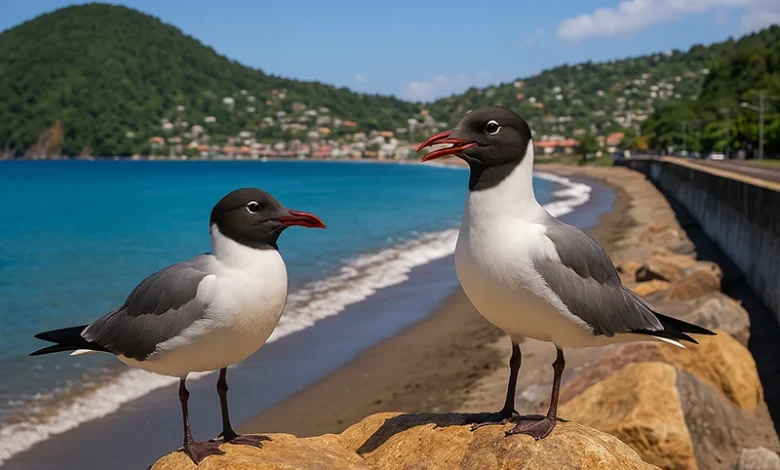Laughing Gull

The Laughing Gull (Leucophaeus atricilla) is one of the most recognizable gulls along Dominica’s coasts, known for its loud, laughing calls and bold black head during breeding season. Common throughout the Caribbean, this medium-sized gull is a frequent year-round visitor and possible breeder in Dominica, especially in areas with calm bays, harbors, and open beaches. It plays an essential ecological role in coastal cleanup and marine food webs.
Appearance and Identification
The Laughing Gull measures about 36–41 cm (14–16 inches) in length with a wingspan up to 102 cm (40 inches). In breeding plumage, adults feature a solid black head, white underparts, gray back, and a dark red bill. Non-breeding adults lose the black head, retaining only smudges around the eyes. Juveniles are brown and mottled before gradually developing adult plumage. In flight, they show white crescents on the trailing edge of their wings.
Habitat and Distribution in Dominica of the Laughing Gull
The Laughing Gull is common in coastal and marine environments throughout the island. Regular observation spots include:
- Prince Rupert Bay and Indian River estuary – Often scavenging along shorelines or resting on boats.
- Deep Water Harbour and Bayfront – Seen around fishing activity and open piers.
- Scotts Head Peninsula and Soufrière – Flying in groups over reefs or roosting on rocks.
- Layou River mouth – Active during fish runs or river flooding events.
- Rosalie and Castle Bruce coastline – Sometimes found resting on driftwood or scavenging seaweed piles.
Behavior and Birdwatching Tips
The Laughing Gull is named for its distinctive, laughing “ha-ha-ha-ha” call that echoes loudly over the sea. It is an opportunistic feeder, eating fish, crabs, insects, garbage, and eggs, and frequently follows boats or flocks of other birds. It’s highly social and often seen in flocks with other gulls and terns.
Birdwatching tips:
- Look along open beaches, fish markets, and harbor walls.
- Scan the sky near reef edges or tidal zones—they often fly low and circle.
- Best viewing occurs during early morning and late afternoon, when feeding activity is high.
- Observe behavior closely—Laughing Gulls often squabble loudly over scraps or fish.
Nesting and Local Name
The Laughing Gull may nest on offshore cays or remote parts of coastal cliffs, though no large colonies are confirmed in Dominica. In the wider Caribbean, it nests in dense ground colonies, laying 2–4 eggs in shallow scrapes.
🔎 Local name in Dominica: While no confirmed unique Creole name exists for the Laughing Gull specifically, it is sometimes loosely referred to by locals as a “Sea Crow” or “Gwo Mouchwa” (meaning large seabird or noisy gull), depending on the region.
The Laughing Gull is a lively, loud, and unmistakable feature of Dominica’s coast—part scavenger, part sentinel, and entirely at home in the island’s maritime rhythm.




